Gongkar
Gongkar, de son complet nom Sonam Gompo Gokharwa (ca 1898 / 99 - 1917 / ), est un militaire tibétain.
Biographie
Gongkar est l'un des quatre jeunes Tibétains envoyés en 1913 en Angleterre pour y faire des études et y suivre une formation professionnelle, les trois autres étant Ringang, Möndro et Kyibu II. Ces visites ont été approuvées par sir Charles Bell et le 13e dalaï-lama[1]. Arrivés le , ils furent tous admis à l'académie militaire de Heathend (en), puis à la public school de Rugby. Il est décrit comme l'élève le plus doué des quatre[2]. En juin, ils furent reçus avec Lungshar en audience par le couple royal.
Il a étudié à l'Académie royale militaire de Woolwich dans le sud de Londres en Angleterre et obtint un diplôme en science militaire, puis suivit une formation d'officier auprès de l'armée des Indes britanniques[3].
On rapporte que l'épouse de Lungshar parvint à séduire l'un des quatre garçons[4], à priori Gongkar[5]. Elle quitta l'Europe avec son mari en 1914, et était alors enceinte.
Carrière
Gongkar suivit la formation militaire britannique et fut le premier des quatre garçons à retourner au Tibet. A Lhassa, il a instruit les soldats tibétains sur les nouvelles techniques militaires. Par la suite, lui et deux jeunes officiers furent en poste à Shigatsé. Selon Sir Charles Bell, il a développé l'armée tibétaine rapidement à Shigatsé[6]. Selon Lhalu Tsewang Dorje, on attendait de Gongkar qu'il réorganise l'armée tibétaine, mais il fut affecté à un poste frontière du Kham pour des raisons politiques[2],[7].
Selon K. Dhondup, un historien tibétain, il est retourné au Tibet en et est mort de la malaria en à Lhassa[8].
La date de la mort de Gongkar n'était pas tout à fait sûr. Selon David Macdonald, il serait mort en 1917 des suites d'une pneumonie[9].
Notes et références
- (en) Harris, Clare & Tsering Shakya (2003) Seeing Lhasa: British depictions of the Tibetan capital 1936-1947, (ISBN 978-1932476040), p. 40 et 121 « (arranged by Sir Charles Bell and the 13th Dalai Lama) » et « All civil or criminal disputes in Lhasa were brought before the Mipon's office »
- (en)Ford, Robert W., Wind Between the Worlds, New York: David McKay Company, Inc, 1957, p. 107-110
- (en)Lamb, Alastair (1966) Tom Browns From Central Asia, in: McKay, Alex (2003) The History of Tibet, deel III: The Modern Period: 1895-1959, Rootledge, New York et Londres, (ISBN 978-0415308441), pag. 327
- Alastair Lamb, op. cit. , p. 326 : « his wife undertook, with considerable success, the seduction of one of the Tibetan boys. »
- Michael Harris Goodman, Le Dernier Dalaï-Lama ?, p. 127
- (en)Bell, Charles (1924, herdruk 1997) Tibet, Past and Present, D.K. Fina Art Press, Delhi, page 163, (ISBN 978-8175360877)
- Robert W. Ford, op. cit., p. 109 : « Ghonkar had gone to Woolwich, and was expected to remodel the Tibetan army. But for political reasons he had been posted to a frontier station in Kham, and he died young. »
- (en) K. Dhondup, The Thirteenth Dalai Lama's Experiment in Modern Education. The Tibet Journal, 1984, 9(3): 38-58. p. 46 : « Gongkar returned to Tibet by the middle of March 1919. A telegram dated 17.12.1919 from the Political Officer Sikkim to Secretary Foreign & Political Department, Government of India, reads : "Tibetan trade agent at Gyantse reported that Mr. Gongkar died at Lhasa from malaria about a month ago. »
- (en)Macdonald, David (1932) Twenty Years in Tibet, in: McKay, Alex (2003) The History of Tibet, deel III: The Modern Period: 1895-1959, Rootledge, New York et Londres, (ISBN 978-0415308441), pages 327-328, voetnoot 13
- (nl) Cet article est partiellement ou en totalité issu de l’article de Wikipédia en néerlandais intitulé « Gongkar (militair) » (voir la liste des auteurs).
Liens externes
- Portail du Royaume-Uni
- Portail du Tibet
